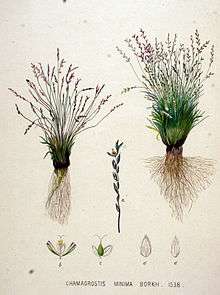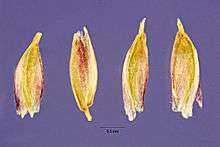Mibora minima
| Mibora minima | |
|---|---|
| | |
| Dried Mibora minima specimen, 9 cm high | |
| Scientific classification | |
| Kingdom: | Plantae |
| (unranked): | Angiosperms |
| (unranked): | Monocots |
| (unranked): | Commelinids |
| Order: | Poales |
| Family: | Poaceae |
| Subfamily: | Pooideae |
| Tribe: | Aveneae |
| Genus: | Mibora |
| Species: | M. minima |
| Binomial name | |
| Mibora minima (L.)Desv. | |
| Synonyms[1] | |
|
List
| |
Mibora minima, the early sandgrass,[2] is a small (between 2 and 15 cm high) annual species of grass that is indigenous in western and southwestern Europe and is also known from both sides of the Canada–United States border east from Lake Huron and west from Maine. It grows on moist sand in open vegetations.[3]
Description

Etch from the Flora Batava

florets, 2nd from left facing up
Mibora minima is a petit annual species of grass, with tufts of thin stems of about 0.3 mm wide and 10 cm long, each with 2 or 3 leaves at or very near the base, consisting of tender, shallowly grooved sheaths, rounded at their back, 0.2–1 mm long ligules, flat or enrolled blades of 1–5 cm long which are up to 0.5 mm wide and have a stump tip.[3]
References
- ↑ Mibora minima en PlantList
- ↑ "Mibora minima". Natural Resources Conservation Service PLANTS Database. USDA. Retrieved 28 January 2016.
- 1 2 Editorial Committee of the Flora of North America (1993). Flora of North America: Magnoliophyta: Commelinidae (in part): Poaceae, part 1. Oxford University Press.
This article is issued from Wikipedia - version of the 8/9/2016. The text is available under the Creative Commons Attribution/Share Alike but additional terms may apply for the media files.